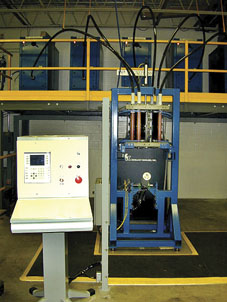 The forming process is most often used to shrink or expand cylindrical tubing, but it can also form sheet metal by repelling the workpiece onto a shaped die at a high velocity. Since the forming operation involves high acceleration and deceleration, mass of the workpiece plays a critical role during the forming process. The process works best with good electrical conductors such as copper or aluminum, but it can be adapted to work with poorer conductors such as steel. EMF offers elegant approaches to forming complex components and can improve forming limits in metals. It is the only high velocity forming technique to gain significant acceptance in commercial metal working. The electromagnetic forming technique has been in use commercially for the last 30 years. Mostly, it has been used for joining and assembly of concentric parts. The minimal springback inherent in all high velocity forming processes provides high-quality joints. One of the most common applications of electromagnetic forming is the compression crimp sealing and assembly of axi-symmetric components such as automotive oil filter canisters. As the name implies, in this technique, electromagnetic forces are used to form the material. A current pulse from a capacitor bank is passed through a coil that is placed in close proximity to a workpiece. The current pulse causes a high-magnetic field around the coil. This field induces an eddy current in the workpiece and an associated secondary magnetic field. The two fields are repulsive and the force of magnetic repulsion causes deformation of the workpiece. The nature of the electromagnetic forming process makes it highly suitable for automation. Results obtained are very repeatable because energy discharge characteristics are controlled essentially by the non-changing electrical parameters of the system and precise control of capacitor bank charge voltage. The fundamental physical characteristic of this technique is that the deformation forces initially are only magnetic body forces generated within the material by eddy currents induced by the drive coils. Surface pressures only occur upon contact with the form tool. This can provide deformation capabilities that are difficult to obtain with other forming methods.
The forming process is most often used to shrink or expand cylindrical tubing, but it can also form sheet metal by repelling the workpiece onto a shaped die at a high velocity. Since the forming operation involves high acceleration and deceleration, mass of the workpiece plays a critical role during the forming process. The process works best with good electrical conductors such as copper or aluminum, but it can be adapted to work with poorer conductors such as steel. EMF offers elegant approaches to forming complex components and can improve forming limits in metals. It is the only high velocity forming technique to gain significant acceptance in commercial metal working. The electromagnetic forming technique has been in use commercially for the last 30 years. Mostly, it has been used for joining and assembly of concentric parts. The minimal springback inherent in all high velocity forming processes provides high-quality joints. One of the most common applications of electromagnetic forming is the compression crimp sealing and assembly of axi-symmetric components such as automotive oil filter canisters. As the name implies, in this technique, electromagnetic forces are used to form the material. A current pulse from a capacitor bank is passed through a coil that is placed in close proximity to a workpiece. The current pulse causes a high-magnetic field around the coil. This field induces an eddy current in the workpiece and an associated secondary magnetic field. The two fields are repulsive and the force of magnetic repulsion causes deformation of the workpiece. The nature of the electromagnetic forming process makes it highly suitable for automation. Results obtained are very repeatable because energy discharge characteristics are controlled essentially by the non-changing electrical parameters of the system and precise control of capacitor bank charge voltage. The fundamental physical characteristic of this technique is that the deformation forces initially are only magnetic body forces generated within the material by eddy currents induced by the drive coils. Surface pressures only occur upon contact with the form tool. This can provide deformation capabilities that are difficult to obtain with other forming methods. How EMF works
EMF works by the magnetic induction effect. When a coil or solenoid is placed near a metallic conductor and pulsed via an energy store like a capacitor bank, a magnetic field is generated between the coil and the workpiece. If done quickly enough, the magneticAir Jordan XII 12 Shoes













